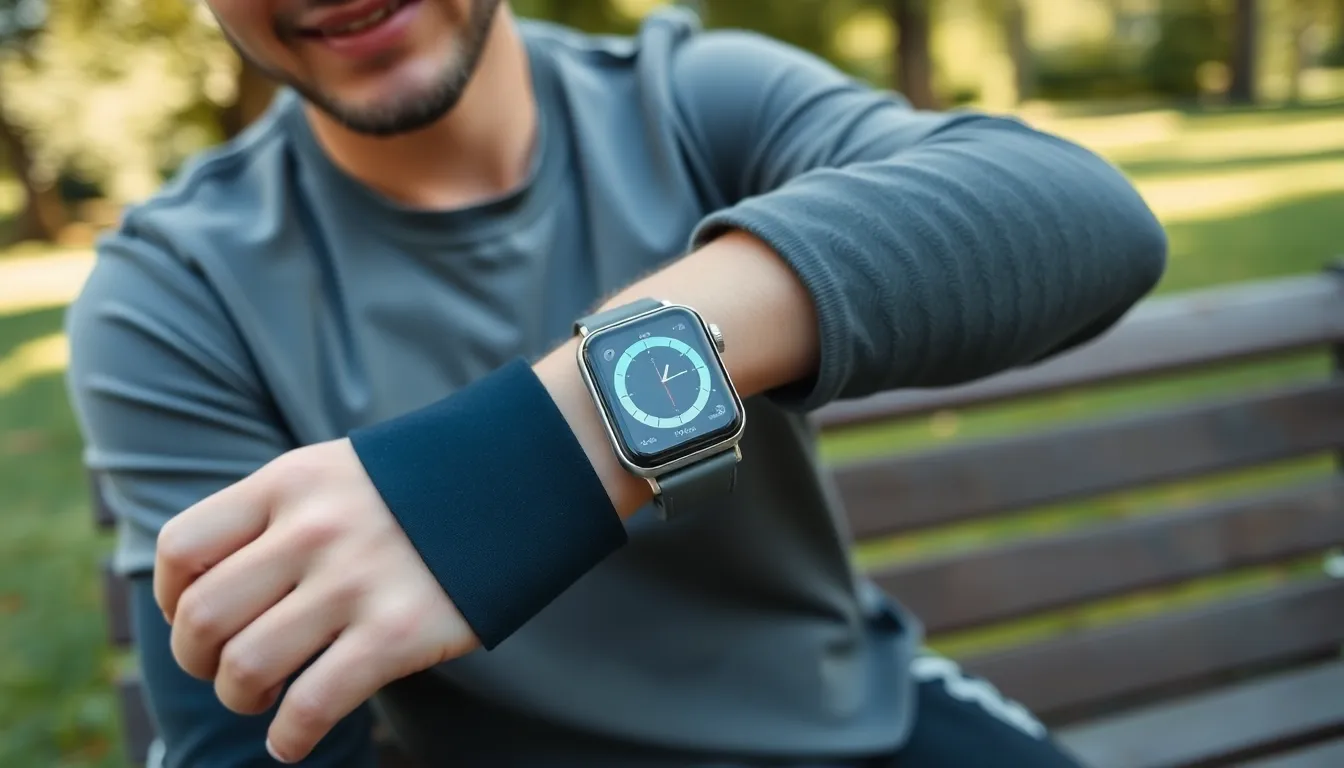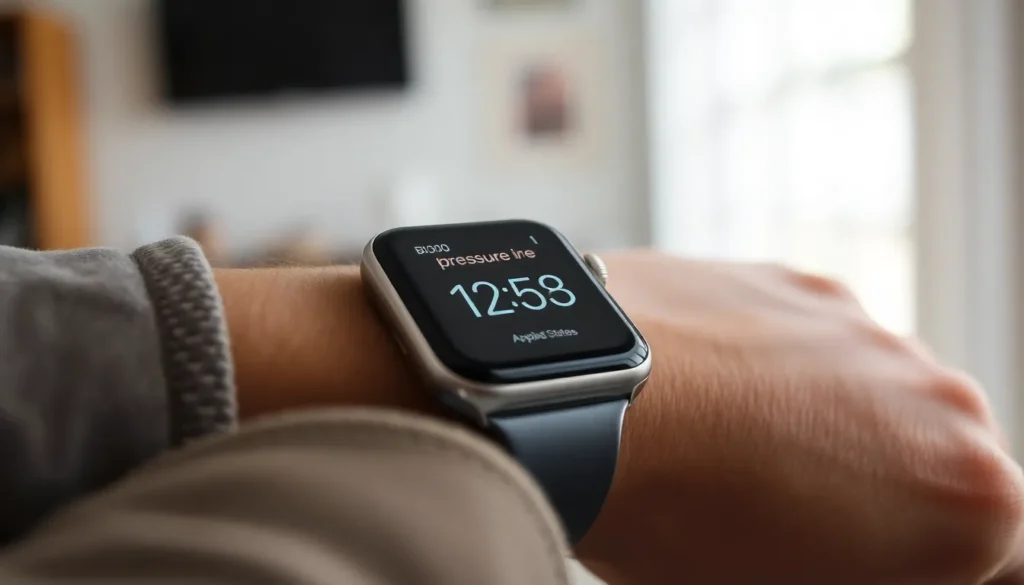In a world where the latest tech trends can feel overwhelming, the Apple Watch blood pressure monitor stands out as a game-changer. Imagine having your very own health assistant right on your wrist, ready to keep tabs on your blood pressure while you conquer your day. No more awkward trips to the doctor or those outdated cuff devices that make you feel like a science experiment.
With this sleek gadget, tracking your health becomes as easy as checking the time. It’s not just about style; it’s about staying informed and proactive. Whether you’re a fitness fanatic or someone who just wants to keep an eye on their heart health, the Apple Watch blood pressure monitor offers a blend of innovation and practicality that’s hard to resist. So why not let your wrist do the heavy lifting while you focus on living your best life?
Table of Contents
ToggleOverview of Apple Watch Blood Pressure Monitor
The Apple Watch blood pressure monitor serves as an innovative health tool for users. Tracking blood pressure from the wrist promotes convenience and accessibility, eliminating uncomfortable visits to the doctor.
Features of the Apple Watch
Apple Watch models equipped with blood pressure monitoring offer an array of features. Users benefit from an intuitive interface that simplifies reading blood pressure readings. Integration with the Health app allows seamless tracking and storage of health data. Notifications alert users of abnormal readings, encouraging timely actions. Stylish designs cater to various preferences, making health monitoring appealing. Battery life extends throughout the day, ensuring reliable performance without frequent charging.
How It Works
The Apple Watch blood pressure monitor utilizes advanced sensors to gauge arterial pressure. Wearers must follow precise calibration processes to ensure accurate readings. An algorithm processes data from the sensors, translating it into understandable numbers. Users easily view their blood pressure levels through the watch’s display. Data syncs with the paired smartphone, providing insight into trends over time. Consistent usage enhances accuracy, with reminders promoting regular monitoring.
Accuracy and Performance

Accuracy is vital for any health monitoring device. The Apple Watch integrates advanced sensors that provide reliable blood pressure readings. Performance relies on a calibration process that compares its readings against traditional blood pressure monitors. Users report that the device maintains close alignment with standard measurements, enhancing confidence in its data.
Comparison with Traditional Monitors
When comparing the Apple Watch blood pressure monitor with traditional monitors, significant differences emerge. Traditional monitors utilize inflatable cuffs for accurate readings, while the Apple Watch employs sensors embedded in the device. Users find that the watch offers a more ergonomic and less intrusive monitoring experience. Moreover, many consumers appreciate the convenience of real-time updates, which traditional monitors do not provide. This advancement allows for easier tracking and management of blood pressure trends over time.
Real-World User Experiences
User experiences reflect the Apple Watch’s effectiveness as a blood pressure monitor. Many users share positive feedback about the watch’s seamless integration with the Health app. They appreciate receiving notifications for abnormal readings, which aids in proactive health management. Testing the watch alongside traditional monitors, numerous users report minimal discrepancies in readings. Those who prioritize health monitoring find the watch’s portable design encouraging for regular checks, fostering better engagement with personal health.
Compatibility and Integration
Compatibility with various Apple Watch models allows users to track blood pressure efficiently. This device primarily supports Apple Watch Series 4 and newer models, ensuring that most users gain access to this health monitoring feature.
Supported Models
Apple Watch Series 4, 5, 6, 7, and 8 work seamlessly with the blood pressure monitoring feature. Each supported model includes advanced sensors for accurate readings. An upgraded watchOS version may enhance performance further, ensuring optimal functionality.
What Apps to Use
Users can harness the Health app to monitor their blood pressure readings effectively. This application provides a straightforward interface for logging data and analyzing trends. Third-party apps may also complement this feature, offering extended capabilities for health management and tracking specific fitness goals. Apple’s App Store contains various compatible health apps, granting users flexibility in their monitoring preferences.
Benefits of Using the Apple Watch Blood Pressure Monitor
The Apple Watch blood pressure monitor offers several advantages for users seeking to manage their health effectively.
Convenience and Accessibility
Convenience plays a crucial role in the Apple Watch’s appeal, allowing users to check their blood pressure anytime, anywhere. The wrist-mounted device eliminates the need for bulky equipment, making it easy to incorporate blood pressure monitoring into daily routines. Accessibility is also a strong point, especially since the feature is available on Apple Watch Series 4 and newer models. Users can find reassurance in the seamless integration with the Health app, which stores data and trends for easy reference. Effortlessly syncing data with a paired smartphone ensures that health information remains organized and readily available.
Motivation for Health Tracking
Motivation significantly influences health tracking habits, and the Apple Watch excels in this regard. Notifications for abnormal readings encourage consistent checking and prompt users to maintain awareness of their cardiovascular health. Setting personalized health goals instills a sense of responsibility, making users proactive in their wellness journeys. Many users find that having detailed insights about their blood pressure fosters better lifestyle choices, such as diet and exercise adjustments. Engaging features like reminders and challenges boost motivation, creating a more dynamic experience while monitoring health.
Limitations and Considerations
The Apple Watch blood pressure monitor offers impressive features, yet some limitations exist that users must consider.
Potential Accuracy Issues
Accuracy may vary when comparing the readings from the Apple Watch to traditional monitors. Users report instances where readings differ by several mmHg. Factors like wrist position, movement, and optimal skin temperature significantly influence results. Calibrating the device regularly improves precision. Medical professionals recommend pairing the Apple Watch with a conventional device for comprehensive monitoring. This dual monitoring approach ensures users maintain an accurate understanding of blood pressure trends.
Privacy Concerns
Privacy remains a crucial consideration for Apple Watch users. Sensitive health data synchronizes with the Health app, which raises concerns about data security. Users should be aware that sharing data with third-party apps can expose personal information. Apple emphasizes its commitment to user privacy, yet individuals must regularly check privacy settings and manage data sharing preferences. Frequent updates to app permissions help protect sensitive information from unauthorized access.
The Apple Watch blood pressure monitor stands out as a game-changer in personal health management. With its sleek design and user-friendly interface, it empowers individuals to take charge of their well-being effortlessly. The integration with the Health app and real-time notifications enhances the overall experience, making health tracking more engaging and proactive.
While it offers remarkable convenience, users should remain aware of potential accuracy variations and privacy considerations. Regular calibration and thoughtful data management are essential for maximizing the benefits of this innovative device. As technology continues to evolve, the Apple Watch blood pressure monitor represents a significant step toward a healthier lifestyle, encouraging users to stay informed and proactive about their heart health.







